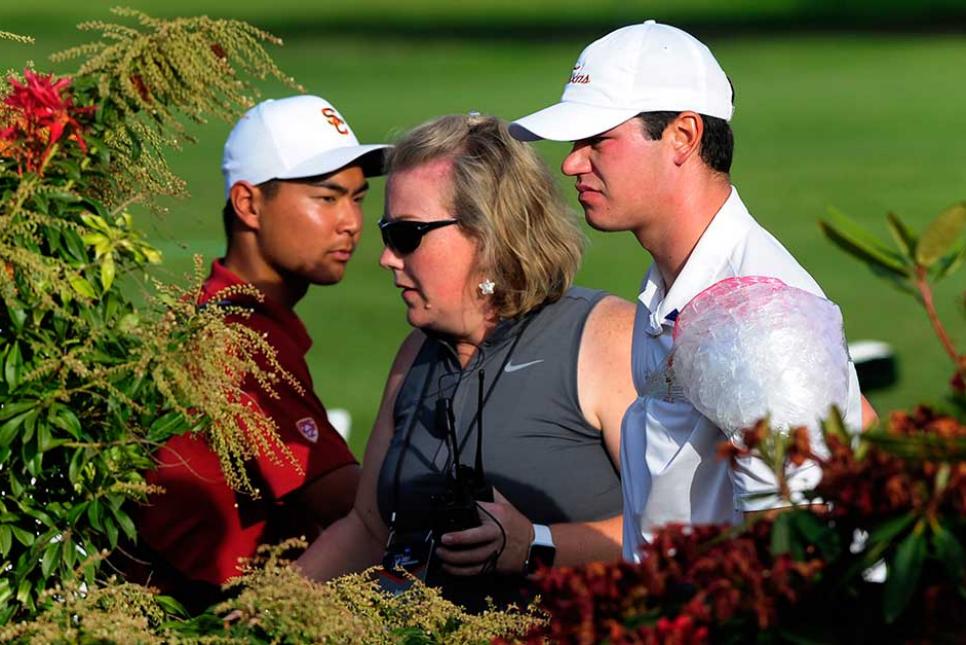The seemingly inevitable is happening in college golf. Well, maybe.
Last May, when injured Texas All-American Beau Hossler sat out the NCAA Championship’s final match against eventual winner Oregon—leaving the Longhorns immediately down 0-1 and needing to get three points out of their remaining four starters to claim the title (which they nearly did)—it was clear some sort of substitution rule allowing coaches to replace players in their lineups was likely to be proposed moving forward. The social-media outcry from those watching the championship on TV—and commenting on the fairness of Texas playing short-handed—made it a virtual certainty.
Sure enough, the NCAA Men’s Division I golf committee has followed through. During their July board meeting, minutes of which were made public on Thursday, committee members voted to recommend that substitutions be permitted, at coaches’ discretions, during the NCAA D-I regionals and nationals starting in 2017.
Not all coaches, however, are pleased with the news, which began to trickle out during last month’s U.S. Junior Amateur, when an NCAA representative met with those in attendance at the Honors Course to explain the recommendation. Moreover, the proposal still must be approved by the NCAA Championships Oversight Committee, which meets in October, giving detractors time to make their voices heard and possible delay its implementation.
Part of the concern for some stems from the fact that the committee’s proposal allows substitutions to be made at the coaches’ discretion, rather than strictly based on illness or injury. In a survey of men’s coaches conducted shortly after NCAAs by the Golf Coaches’ Association of America, only 39 percent said they were in favor of such a broad measure, compared to 55 percent who approved the idea if replacements were allowed solely for injuries.
According to notes from the golf committee report, in reviewing the matter, members became concerned about how officials might administer whether a player was sufficiently hurt or sick to constitute a coach making a switch.
“The committee does not want to be put in the position of determining whether and injury or illness is serious enough to allow a substitute,” states its report. “Accordingly, the committee believes substitutions being at the coaches’ distraction is the most logical way to proceed.”
Beyond semantics, other coaches wondered about the logic of changing the rule in the year’s two biggest tournaments rather than first experimenting with the concept during the regular season. Indeed, the proposal only applies for postseason competition, in part because that’s all the NCAA Men’s D-I golf committee officially has jurisdiction over.
Interestingly, the NCAA Women’s D-I golf committee also discussed the matter during its July board meeting, with the talks directed toward whether to allow substitutions during the match-play portion of the NCAA Women’s Championship. The committee, however, decided to hold off on any specific recommendations until it received additional feedback from coaches through collaboration with the Women’s Golf Coaches Association of America. Whether that might come before the October meeting of the Championships Oversight Committee, and thus allow for a rule to be put in for next spring, is unclear.
One change the Women’s golf committee did recommend, after a decade of discussion, is the adoption of the “.500 rule” that sets a minimum winning percentage for teams to be eligible to receive at-large bids to NCAA Regionals. Beginning in 2017-’18, schools would have to have a .500 or better record against Division I opponents (a criteria used by the men since 2007-’08) to be able to play in the postseason without having won the automatic qualifier for winning their conference championship.
The rule could have an immediate impact as six schools that advanced to Regionals in 2014-’15 and three in 2015-’16 were selected despite having a losing record against their competition.
